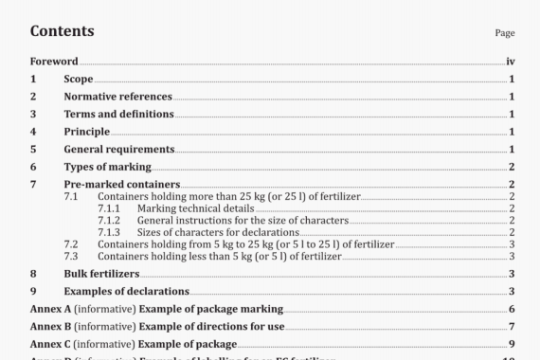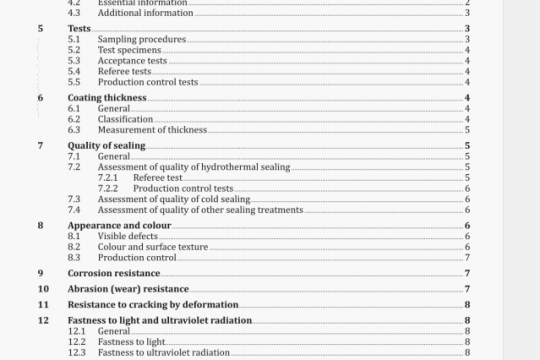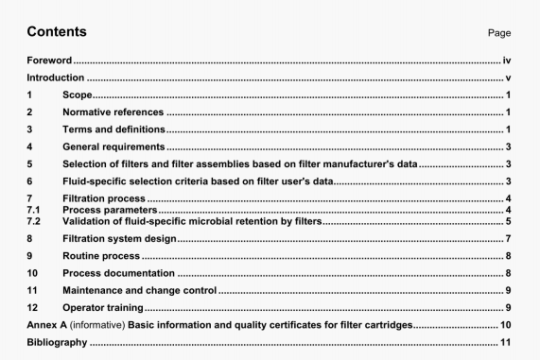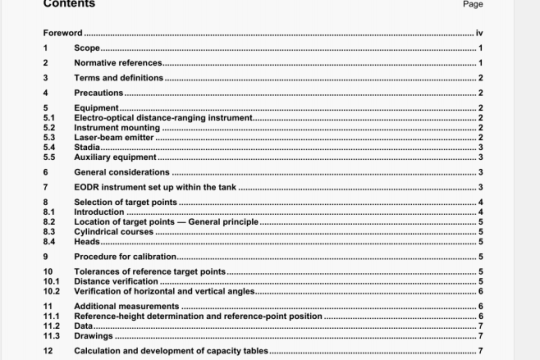ISO 13472-1:2002 pdf download
ISO 13472-1:2002 pdf download.Acoustics一Measurement of sound
absorption properties of road surfaces in situ- Part 1: Extended surface method.
5 Test system
5.1 Components of the test system
The test equipment shall comprise an electroacoustic system, consisting of an electronic signal generator, a power amplifier and a loudspeaker, a microphone with amplifier and a signal analyser capable of performing cross- correlation and transformations between the time and the frequency domains.
A sketch of the essential components of the measuring system is shown in Figure 1.
The complete measuring system shall meet the requirements of at least a type 2 instrument in accordance with IEC 60651. For the purposes of this part of ISO 13472, the measurement frequency range is displayed in one-third- octave bands, from 250 Hz to 4 kHz.
5.2 Sound source
The loudspeaker shall
— have either a single or a coaxial cone in a closed cabinet, and
— have a smooth frequency response without sharp irregularities throughout the measurement frequency range, resulting in an impulse response under free-field conditions with a length not greater than 2 ms.
5.3 Test signal
The test signal shall consist of a repeatable short signal with a low peak-to-RMS ratio, typically below 2, and an energy content that covers the one-third-octave bands from 250 Hz up to 4 kHz with an acceptable S/N ratio. Several signals may be used, such as maximum-length sequences (MLS, see annex D) or short frequency sweeps.
6 Data processing
6.1 Calibration
The measurement procedure described in this part of ISO 13472 is based on the power ratio of two transfer functions extracted from the same electroacoustical chain. An absolute calibration of the measurement chain with regard to the sound pressure level is, therefore, unnecessary. However, a reference measurement as described in annex B is required.
6.2 Sampling frequency
The subtraction principle implies knowledge of the exact wave form, especially for checking change of time delays in the measurement chain. The sampling frequency f shall therefore have a value greater than 40 kHz.
NOTE Although the signal is already unambiguously defined when the Nyquist criterion is met, higher sampling frequencies facilitate a clear reproduction of the signal. Errors can be detected and corrected more easily, such as corrections needed to account for time shifts due to temperature changes.
6.3 Recovery of the overall impulse response
The overall impulse response is obtained through a cross-correlation between the electronic source signal and the received microphone signal (see annex D).
This location of the source and the microphone shall be such that the maximum sampled area (see 7.1 and annex A) is totally included in the road surface under test.
7.3 Reflecting objects
Any object other than the road pavement shall be considered a reflecting object which could cause parasitic reflections (e.g. fences, rocks, anti-noise barriers, parked cars). These objects shall remain out of the maximum sampled area at a distance to the microphone greater than d.
Care shall be taken that the microphone stand does not influence the measurement.
7.4 Background noise
The signal-to-noise ratio SIN shall be larger than 10 dB within each one-third-octave band between 250 Hz and 4 kHz.
NOTE Coherent detection techniques, such as the MLS cross-correlation, provide high S/N ratios (see annex D).
7.5 Safety considerations
This test method may involve hazardous operations when measurements are performed on roads where there is traffic. This part of ISO 13472 does not purport to address all of the safety problems associated with its use. It is the responsibility of the user of this part of ISO 13472 to establish appropriate safety and health practices and determine the applicability of regulatory limitations prior to use.
8 Road surface and meteorological conditions
8.1 Condition of the road surface
The road surface under test shall be visually homogeneous and free of changes in the material properties.
Measurements shall not be carried out unless the road surface is dry. If the road surface can be expected to have a significant void content, then it should be verified that the pores are dry.
Measurements which for study or research purposes specifically aim at determining the influence of weather or other environmental conditions on sound absorption may be carried out when the road surface is not dry, but the results cannot be used for classification or qualification of the road surface under test.
8.2 Wind
The wind speed at microphone height shall not exceed 5 m/s during the measurements.
8.3 Temperature
The ambient air temperature shall be between 0 °C and 35 °C during the measurements. The road surface temperature shall be between 0 °C and 50 °C during the measurements.




